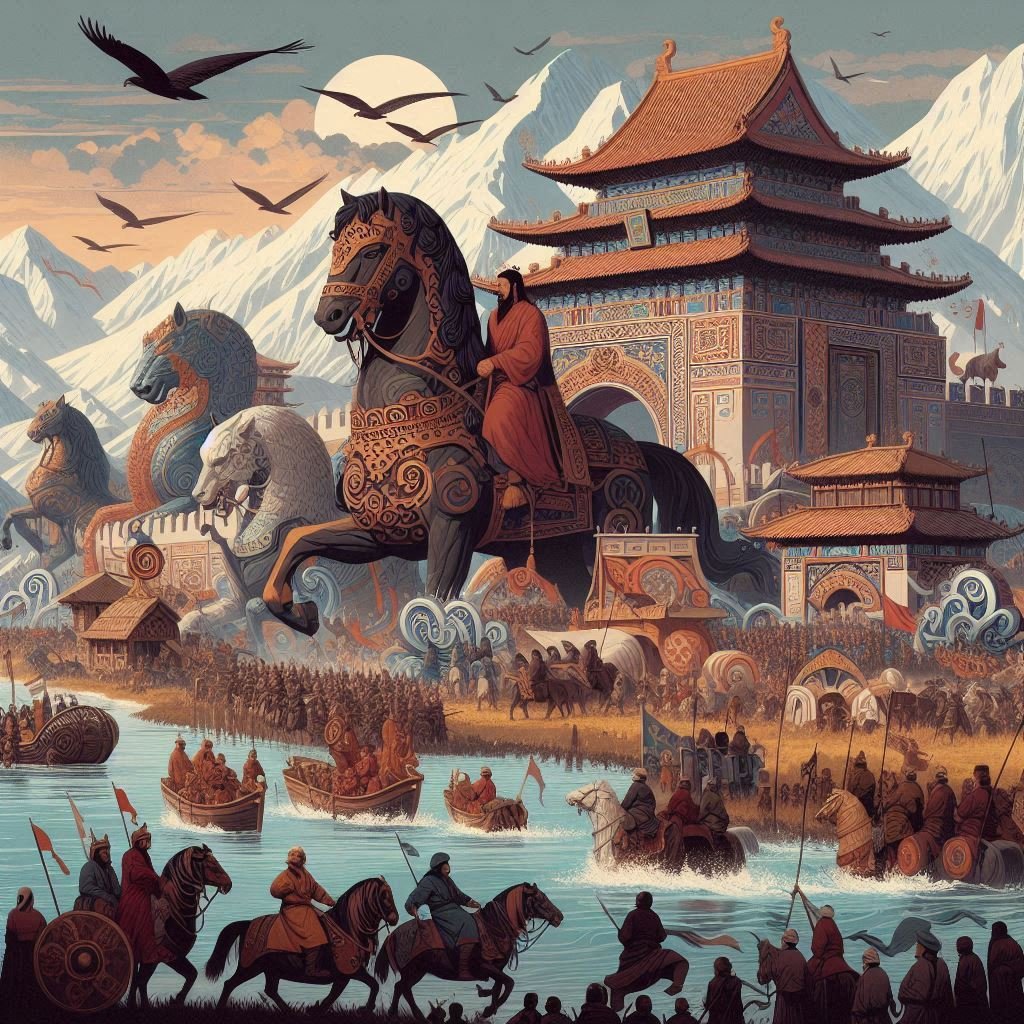Introduction: The Rise of a Nomadic Superpower
The Mongol Empire, established by Genghis Khan in 1206 CE, remains one of the most remarkable empires in history. At its peak, it was the largest contiguous empire the world had ever seen, stretching across Eurasia from China in the east to Europe in the west. Despite their origins as nomadic horsemen, the Mongols reshaped the political, economic, and cultural landscape of the 13th and 14th centuries.
Through military strategy, cunning diplomacy, and ruthless efficiency, Genghis Khan united the Mongol tribes, leading them on a campaign of conquest that changed the course of history.
Genghis Khan: Uniting the Mongols
The Mongol Empire’s foundation was laid by Genghis Khan (born Temujin), a visionary leader who unified the fractious Mongol tribes in 1206 CE. By organizing his army with a system of meritocracy and harsh discipline, he forged a military machine that was almost unstoppable.

Genghis Khan’s military genius allowed him to defeat powerful enemies like the Jin Dynasty in northern China and the Khwarezmian Empire in Persia, using tactics like feigned retreats and psychological warfare. His ability to adapt and learn from his enemies also allowed the Mongols to quickly integrate new technologies, such as siege warfare techniques.
“If you had not committed great sins, God would not have sent a punishment like me upon you.” – Genghis Khan
Mongol Military Tactics: Facts and Figures
| Figures & Facts | Details |
|---|---|
| Genghis Khan’s Reign | 1206 CE – 1227 CE |
| Mongol Army Size | Approx. 100,000 – 200,000 soldiers |
| Conquered Lands | Approx. 16% of the world’s total landmass |
| Tactics | Horse archers, feigned retreats, siege warfare |
The Expansion of the Mongol Empire
Under Genghis Khan and his successors, particularly Kublai Khan, the Mongol Empire expanded rapidly. By 1279 CE, it had conquered territories across China, Persia, Central Asia, and Eastern Europe. The empire’s expanse allowed for unprecedented trade and cultural exchange along the Silk Road, connecting the East and the West.

The Mongols established a system of communication and trade routes that spanned across Eurasia, promoting the flow of goods like silk, spices, and precious metals. The Mongols also tolerated different religions, allowing Buddhism, Christianity, Islam, and other beliefs to coexist within their territories.
“The Mongols brought the world together through destruction and trade.” – Historian Jack Weatherford
Mongol Expansion: Facts and Figures
| Figures & Facts | Details |
|---|---|
| Empire’s Extent (c. 1279 CE) | 9.27 million square miles |
| Population of Empire | Estimated 100 million people |
| Mongol Invasion of Europe | Reached Hungary and Poland by 1241 CE |
| Silk Road | Reinvigorated trade route between East and West |
Kublai Khan: The Yuan Dynasty and China
After Genghis Khan’s death, his empire was divided among his sons and grandsons, creating four khanates. The most notable successor was Kublai Khan, Genghis Khan’s grandson, who became the Great Khan in 1260 CE and established the Yuan Dynasty in China in 1271 CE.

Under Kublai Khan’s rule, the Mongols adapted to the administrative needs of a sedentary empire. Kublai maintained Mongol military dominance but also adopted Chinese administrative practices. The Yuan Dynasty ruled China until 1368 CE, when the native Ming Dynasty overthrew them.
Kublai’s reign was marked by cultural exchange and the flourishing of the Silk Road, which brought scholars, traders, and emissaries from Europe, the Middle East, and Asia into contact with the vast Mongol world.
“Kublai Khan established a dynasty but lived like a nomad.” – Marco Polo
Yuan Dynasty: Facts and Figures
| Figures & Facts | Details |
|---|---|
| Kublai Khan’s Reign | 1260 CE – 1294 CE |
| Yuan Dynasty | Established in 1271 CE, ended in 1368 CE |
| Cultural Exchange | Persian, European, and Chinese scholars met |
| Marco Polo’s Visit | 1275 CE, described in “The Travels of Marco Polo” |
The Pax Mongolica: Peace and Prosperity
One of the greatest legacies of the Mongol Empire was the Pax Mongolica (“Mongol Peace”), a period of stability and peace across Eurasia during the 13th and 14th centuries. This peace allowed for unprecedented economic growth, cultural exchange, and trade. The Silk Road thrived, and the Mongols facilitated the movement of goods, people, and ideas across the continent.

During the Pax Mongolica, many innovations from the East, including gunpowder, papermaking, and compasses, reached Europe. At the same time, European goods and knowledge flowed eastward, linking the world in new ways.
“Under the shadow of Mongol rule, the world was connected like never before.” – Historian Paul Buell
Pax Mongolica: Facts and Figures
| Figures & Facts | Details |
|---|---|
| Period of Pax Mongolica | c. 1250 CE – 1350 CE |
| Trade Routes | Silk Road flourished, connecting East and West |
| Gunpowder and Paper | Introduced to Europe through Mongol interactions |
| Decline of the Empire | Began after Kublai Khan’s death in 1294 CE |
Conclusion: The Mongol Empire’s Global Legacy
The Mongol Empire not only conquered vast territories but also fostered connections between distant civilizations. Through military might, trade, and diplomacy, the Mongols reshaped the political and cultural landscapes of Eurasia, creating a lasting legacy that influenced the development of the modern world.
The empire’s vast network of trade routes, its cultural tolerance, and its ability to bridge East and West through the Pax Mongolica have left an indelible mark on history. The Mongol legacy lives on in the way we think about empires, globalization, and the spread of ideas across the world.
